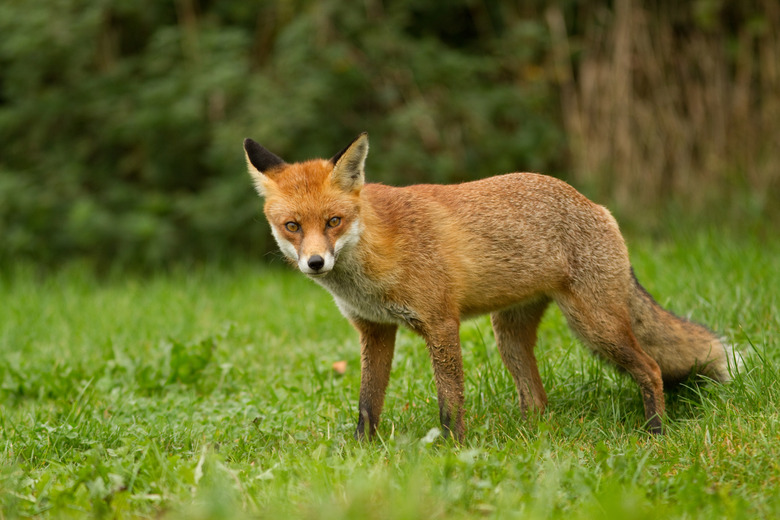What Animals Will Fox Urine Repel?
Red fox urine acts as a repellant for many small mammals, including squirrels, rats, skunks and chipmunks. Fox urine works particularly well as a repellant due to its strong smell and volatile chemical structure. As a result, many people use commercially available fox urine to deter pests from their gardens naturally.
Natural Pest Control
Natural Pest Control
Red foxes (Vulpes vulpes) are the most widely distributed fox species globally. As foxes are predators, fox urine, or fox pee, naturally deters many prey animals. For example, it is well documented that fox pee deters rodents such as rats, mice, squirrels and rabbits. In North America, fox and coyote urine repellants can be used to deter house cats, rabbits, possums, beavers, armadillos, gophers, groundhogs, moles, porcupines, shrews, voles, woodchucks, peccaries, boar, deer and elk.
Fox Urine Repellent
Fox Urine Repellent
Fox urine is a harmless repellent. Smelling fox urine works like a psychostressor for animals that are common prey to foxes. When these animals smell fox pee, it triggers defensive behaviors, such as running away, making it a non-harmful stimulus for avoidance.
For example, gardeners who want to deter squirrels from stealing seeds from a bird feeder can place fox urine on the bird feeder pole. When the squirrel approaches the bird feeder, it smells the fox urine. This triggers a natural evolutionary response in the squirrel to escape the area to avoid being eaten by the "nearby fox."
Fox Urine Scent
Fox Urine Scent
Fox urine has a strong, distinct "skunky" or "musty" scent that humans can easily identify. Foxes are usually solitary animals, but they will often share overlapping territories with other foxes. In the wild, foxes scent mark with their urine, feces and anal glands to communicate with other foxes. Most of the time, foxes scent mark to warn other foxes they are in the area; scent marking is also used to signal to potential mates during the breeding season.
Predator Urine Composition
Predator Urine Composition
Fox urine primarily contains water, urea, creatinine and excess minerals. The chemical composition of fox urine changes throughout the year depending on what the fox eats and what hormonal changes it goes through. It is unknown exactly which component of fox urine prey animals pick up on. In many animals, fox urine deterrents work even if the animal has never been exposed to a fox before.
Typically, single-molecule odors derived from predator urines are more efficient at deterring smaller animals. However, predator urines seem to be more effective, especially with larger animals, if there are traces of the prey animal in them. For example, eastern gray kangaroos were only triggered by Tasmanian devil urine if the Tasmanian devils were fed kangaroo meat before researchers collected the urine samples.
Gardening With Fox Urine
Gardening With Fox Urine
Commercially available fox urine is an effective residential biopesticide repellant for small mammals. It is readily available to purchase online or in gardening stores. It typically comes in loose, granular formations that can be shaken directly on the ground outside. Bags containing fox urine granules can also be hung around a perimeter to deter unwanted animals. To repel animals from indoor areas like sheds, garages, basements or attics, the granules should be placed on a paper plate.
The first application of the granules should be twice a week for two weeks. After that, to maintain pest control, fresh applications should be twice a month. Fox urine packs typically need replacing every 90 days.
Deterring Foxes
Deterring Foxes
In the wild, foxes use their own urine to warn and deter other foxes from their territory, but commercial fox urine does not work well for keeping foxes themselves out of a garden. Male human urine, on the other hand, is said to help deter foxes from gardens. Chemical repellents for foxes include aluminum-ammonium sulfate salts or citronella-scented carbonyl methyl nonyl ketones. Other popular natural fox deterrents include ultrasonic devices, electric fencing, netting, owning guard dogs or placing spicy marinated meat near chicken coops to frighten the fox into not returning.
References
- PLOS ONE: Volatile Scent Chemicals in the Urine of the Red Fox, Vulpes Vulpes
- Journal of General Psychology: Fox Urine as an Aversive Stimulus: Modification of a Passive Avoidance Task
- U.S. Environmental Protection Agency: Biopesticides Registration Action Document for Predator Urines
- New South Wales Department of Primary Industries: Fox Biology
- Wildlife Online: Deterring Foxes
Cite This Article
MLA
Jerrett, Adrianne. "What Animals Will Fox Urine Repel?" sciencing.com, https://www.sciencing.com/animals-fox-urine-repel-5612455/. 30 September 2021.
APA
Jerrett, Adrianne. (2021, September 30). What Animals Will Fox Urine Repel?. sciencing.com. Retrieved from https://www.sciencing.com/animals-fox-urine-repel-5612455/
Chicago
Jerrett, Adrianne. What Animals Will Fox Urine Repel? last modified August 30, 2022. https://www.sciencing.com/animals-fox-urine-repel-5612455/
